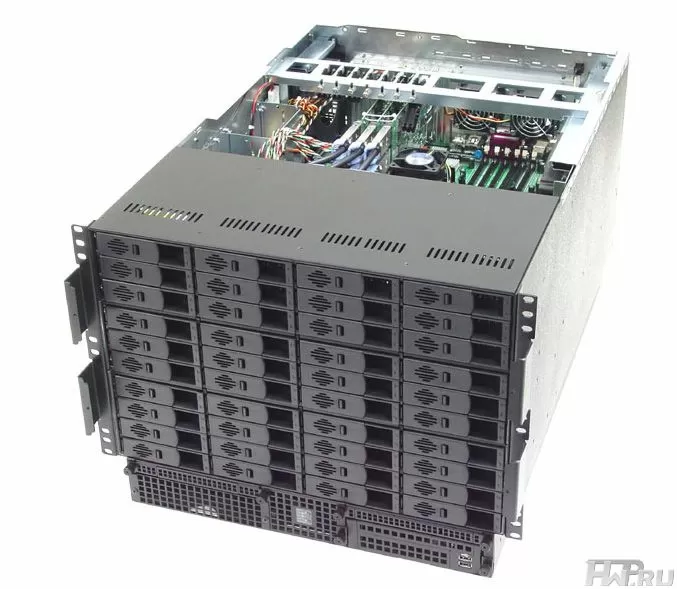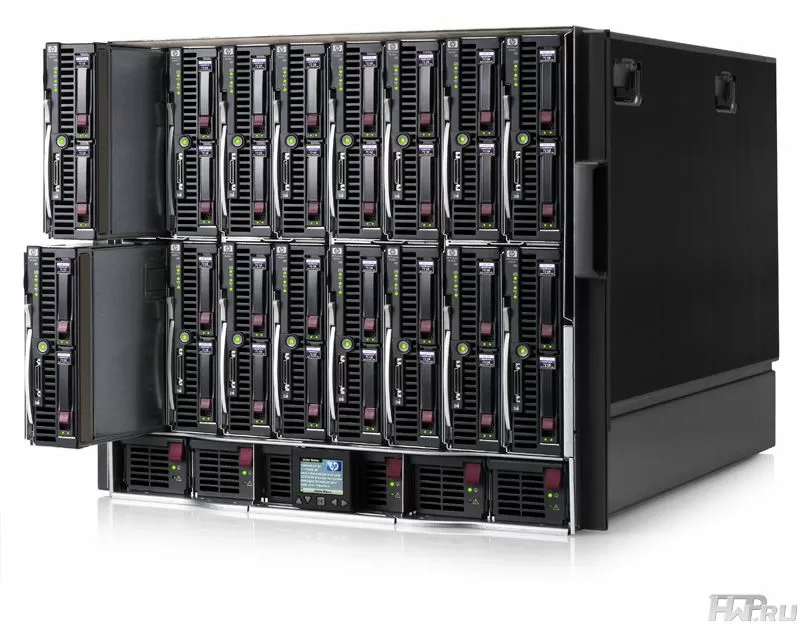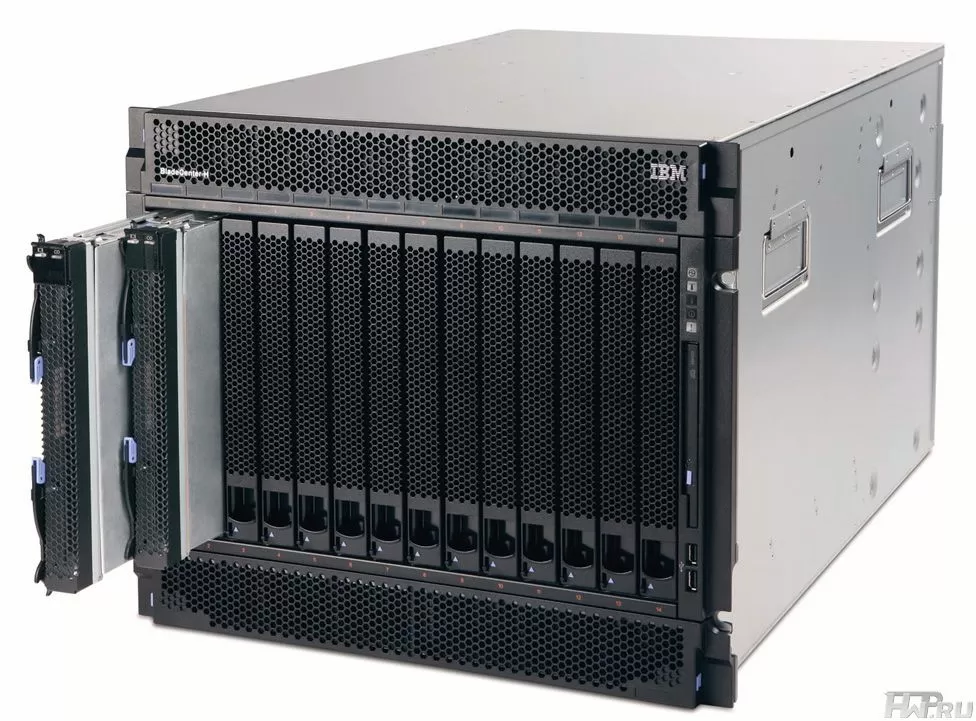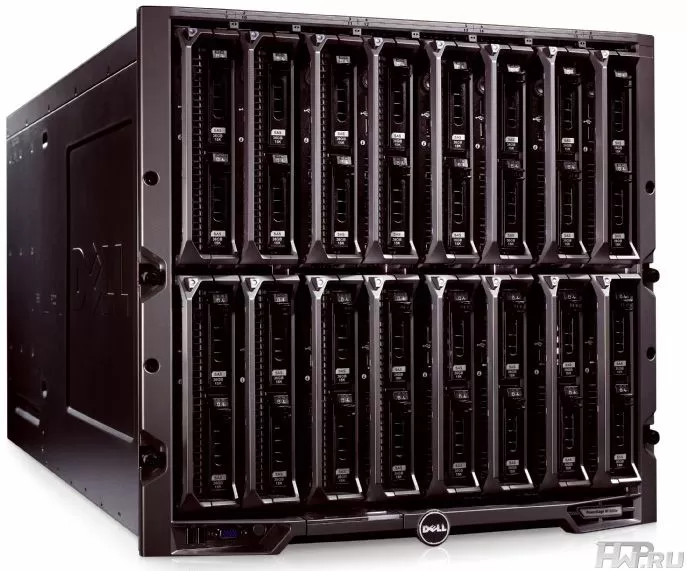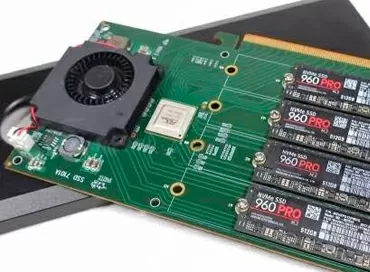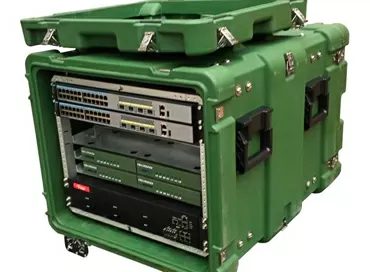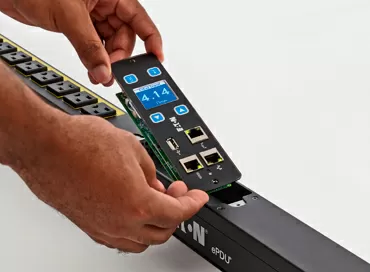Blade servers: their history, main advantages, modern systems
At present, there is a large class of problems that require a high concentration of computational resources. These can include both complex resource-intensive calculations (scientific problems, mathematical modeling, computational search) and serving a large number of users (distributed databases, Internet services and hosting, application servers).
The power of the computing center can be increased by increasing the performance of individual computing modules or their number. Currently, the second trend prevails, and the efforts of developers are primarily aimed at introducing parallel computing.
This is due to the fact that since now the performance of the central processor is very high at a relatively low cost, it is more rational to use cluster configurations for solving most problems, rather than complex multiprocessor systems. In the future, this trend is likely to continue (hope for this allows the emergence of multi-core CPUs, which further narrow the gap in computing power between specialized solutions and simple servers with two & mdash; four CPUs).
The increase in the number of compute modules in a data center requires new approaches to server placement. The use of cluster solutions leads to increased costs for data center premises, their cooling and maintenance.
A new type of server will help solve some of these problems - modular servers, often called Blade servers, or blade servers. The growing popularity of Blade servers are truly 21st century servers (their first models were developed in 2001), whose benefits are described by manufacturers using the 1234 rule. It sounds like this: Compared to conventional servers, with comparable performance, Blade servers take up half the space, consume three times less energy and are four times cheaper.
So what is Blade Server? First of all, it is worth giving the definition of IDC: the analytical company calls a blade (server blade) a modular single-board computer system that includes a processor and memory. The blades fit into a special chassis (or shelf) with a backplane that provides mains connectivity and power. This blade chassis is, according to IDC, a blade system. It is made in a construction for installation in a standard 19-inch rack and, depending on the model and manufacturer, occupies 3U, 6U or 10U in it (one U-unit, or mounting unit, is 1.75 inches). By sharing components such as power supplies, network cards, and hard drives, Blade servers provide higher compute density in a rack than conventional 1U and 2U thin servers such as dell pe r210 or dell pe r410.
Фактически блейд система состоит из следующих компонентов
- Blade-servers (in fact, these are ordinary servers without a power supply, with passive heatsinks and without PCI slots & ndash; removed all "unnecessary components")
- Chassis and passive backplane (board that connects the installed equipment)
- Power and cooling systems (fans, power supplies)
- External switching devices (Ethernet, FC, Infiniband)
Instead of conventional PCI (PCI-E, PCI-X) cards, mezzanine cards are inserted into the server, which allow the use of FC, Infiniband, SAS interfaces, or additional Ethernet ports, if there is an appropriate external switching module in the chassis .
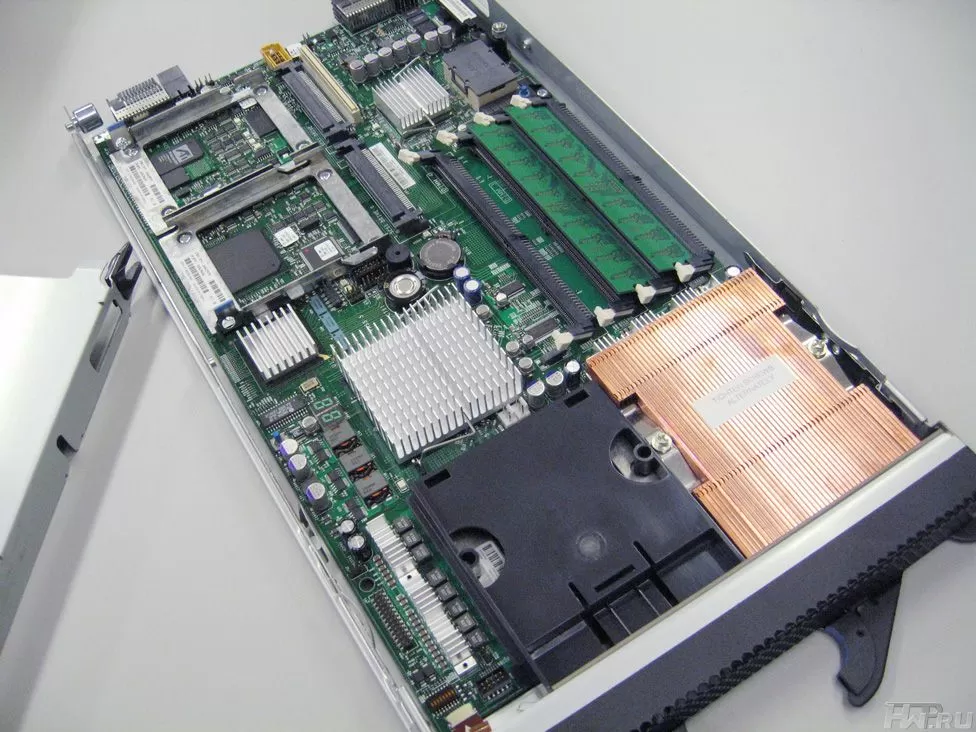
Typical Blade server: no power supply, no fans - nothing more!
Nevertheless, according to analysts, increased blade density is now receding into the background and their main advantage for the corporate sector is improving server manageability with a higher degree of automation of their maintenance. Moving to a server infrastructure built from blades allows for integrated system management and a move away from the old Intel server design, where each application was allocated a separate machine. In practice, this means significantly more rational use of server resources, fewer routine procedures (such as cabling) that a system administrator must perform, and save his time.
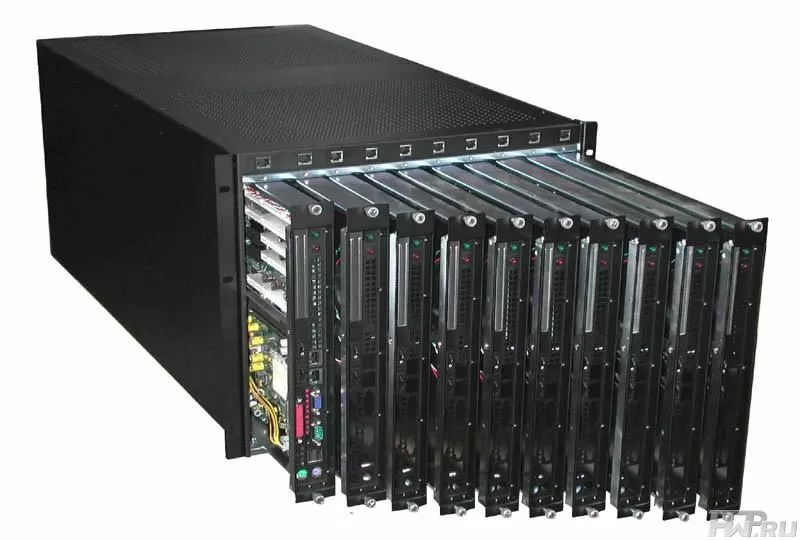
Typical 10U chassis for 10 blade servers
In addition, Blade servers are much easier to maintain than conventional rack servers - for example, if a machine fails, the system administrator simply replaces the blade with a new one and then remotely installs the OS and application software on it ... Currently, the developers of packages for managing Blade servers implement in their products not only the ability to automatically deploy to new OS and application servers, but also the functions of quickly updating installed software or installing software patches.
Blade servers are an extremely effective solution to save space in data processing centers (DC), as well as in terms of their consolidation and transition to centralized management of the server park. For example, a sysadmin can manage a blade chassis as a single object and, as workload increases, increase its processing power by adding new blades. In addition, since it is usually possible to install network switches in the chassis, this option also allows you to consolidate the network resources of the data center.
In addition to reducing the occupied area in the data center, the economic effect of switching to blades has several more components. Because they have fewer components than conventional rack servers and often use low-voltage processor models, the power and cooling requirements for machines are reduced. As mentioned above, the administrator's time is saved, which, as a result, manages to serve more objects, and therefore, with the growth of the server park, the enterprise does not need to hire another administrator. Finally, although the chassis must be purchased along with the blades when moving to a server blade architecture, by sharing the components, further scaling of the blade system is less costly than rack server systems, and a chassis with five to ten blades is less expensive than the same number. conventional rackmount machines.
The benefits of using Blade servers can be summarized as follows:
- reducing the cost and increasing the reliability of the power and cooling system;
- reduction in the number of commutation wires;
- improving the convenience of system management;
- reduction of the occupied volume;
- reduction of energy consumption and heat generated;
- high scalability;
- flexibility.
Of course, "Blade" also has disadvantages:
- lack of a common standard and common platform. For users, this translates into the inability to install, for example, a SUN Blade server in an IBM chassis;
- one point of failure in most Blade systems: the chassis itself is the point of failure of the system. If the chassis fails, then all the "blades" installed in it stand idle, which undoubtedly causes significant damage to the business of their owner. However, you must understand that the chassis itself (body and backplane) is a passive component that can only be physically damaged;
- "Blades" are ineffective for tasks that require a small number of servers (for example, two or three). In this case, it is more profitable to use regular servers without overpaying for the chassis;
- limited class of applications that "Blades" run: because Blade servers are equipped with one or two processors, tasks optimized for traditional servers with a large number of processors are difficult to port to "Blades";
- Poor internal scalability of Blade servers: inability to install expansion cards into servers (the ability to install one low-profile PCI card in some models), small amounts of RAM.
- limited size of the internal disk subsystem - the server usually has a slot for 2 hard drives 2.5. This is due to the fact that blade servers are used for virtualization tasks and the use of an external array is implied.
In general, the implementation of Blade servers brings more positive effect, it is economically beneficial. However, traditionally, the introduction of innovation is resisted by humans. Most companies are wary of purchasing Blade systems, preferring the time-tested rack or tower servers. But every year the volume of sales of Blade servers is growing, more and more solutions based on them appear.
How are Blade servers different from conventional rack servers?
Physical design. The unique physical design provides many of the advantages of Blade systems. Sharing resources such as power, cooling, switching, and management reduces complexity and eliminates the problems associated with more traditional server infrastructures. The physical design of Blade systems involves placing Blade servers in a special chassis (shelf) and its main structural element is the backplane.
The backplane is designed in such a way that it solves all the tasks of switching Blade servers to the outside world: power supply, connections to Ethernet networks, Fiber Channel networks, and also provides SAS (SCSI) interoperability with systems storage in the same chassis (additional disks or tapes). The Blade chassis also accommodates the required Ethernet or Fiber Channel switches for external networking. Pre-installed or optional Ethernet or Fiber Channel controllers provide access to these switches from the Blade servers.
Fewer cables. Connecting to external networks, integrated into a common shelf, significantly reduces the number of cables. The new HP BladeSystem requires 94% less LAN and SAN cabling than traditional rack servers. Switches can be inserted into the chassis to provide interoperability both within the chassis and with external devices.

If you think there are a lot of cables, you are wrong
Shared power and cooling. Placing power and cooling in a shared shelf rather than separate servers results in lower power consumption and increased reliability. In addition, with new and smarter features, energy consumption is reduced. For example, for HP Blade servers, the new HP Thermal Logic cooling technologies reduce total power consumption by more than 30% compared to rack systems, and requires less power and air to cool the entire solution. This is mainly achieved by using more powerful power supplies and fans common to the entire chassis.
Better management capabilities. Blade servers are fundamentally different from rack servers such as dell pe r510 in that the server shelf has intelligence in the form of control modules. HP Blade systems are intelligently managed by a dedicated Onboard Administrator that is not available in traditional server racks. In addition to IP KVM, there are tools for monitoring and managing power, switching modules and tools for rapid system deployment.
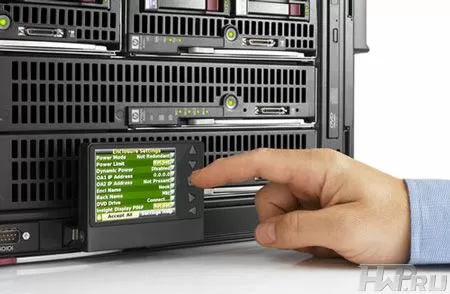
Easy administration of any Blade server in a chassis
No keyboard, video or mouse required. The new HP BladeSystem is managed through a centralized Onboard Administrator and iLO2 Remote Management Processor on each blade, so no separate cables and switches for keyboard, video and mouse (KVM).
Size and density. The servers and infrastructure elements in the HP BladeSystem are smaller and take up less space than comparable rack solutions, helping to conserve energy and IT space ... In addition, due to their modular architecture, they are more convenient to implement and maintain.
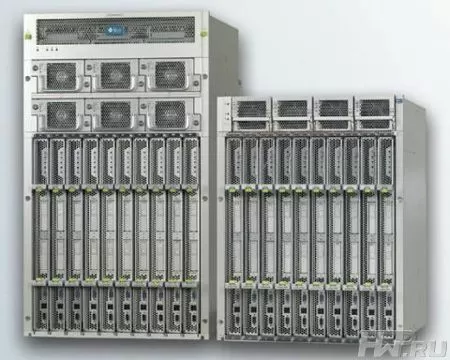
Density is the main advantage of Blade servers
Increased reliability. In traditional rack-mount environments, additional hardware, switching and network components are installed to provide redundancy to increase reliability, at an additional cost. For example, HP BladeSystem has built-in redundancy, and N + 1 redundancy configurations are easier to configure and more cost effective than full redundancy.
Lower operating costs. Blade systems infrastructure is easier to manage than traditional rack IT infrastructures. In some cases, HP BladeSystems have allowed companies to more than double their resources per administrator (servers, switches, and storage systems). Based on average, deployment time for a single ProLiant DL360 rack server is 4 hours and a ProLiant BL460c Blade server is 30 minutes. After installing a server enclosure, adding a new server blade is significantly faster than installing a rack server, which includes mounting the server in a rack, routing cables, installing an operating system, and setting up LAN and storage connections. Any changes are also faster. HP Insight Control software helps IT organizations save time by efficiently deploying, monitoring, and controlling HP BladeSystem infrastructure. By automating key IT processes, it allows employees to focus on more important tasks and act proactively.
Blade Server Evolution
RLX Technologies was the first company to start manufacturing Blade servers. Since RLX is the ancestor of Blade servers, their history is inextricably linked with the development of the company's lineup. Let's take a closer look at the history of the development of Blade servers manufactured by RLX Technologies.
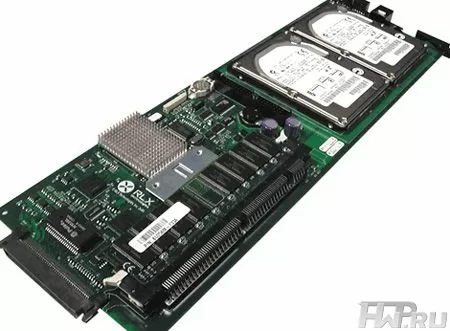
First Blade- server RLX ServerBlade 633
In May 2001, the first generation Blade server, ServerBlade 633, was introduced. To reduce the amount of heat generated, RLX engineers decided to equip the "Blades" with the low voltage Transmeta Crusoe processors used in notebooks. Unfortunately, this solution turned out to be ineffective: in comparison with conventional rack-mount servers, Blades were losing - they were less powerful and overheated.
The second generation servers, ServerBlade 667 , which appeared already in December 2001, had a performance increase of more than 30% compared to ServerBlade 633. In addition, it was possible to install into the same 1st and 2nd generation blade chassis, making it easier to switch to faster blades. The second generation Blade servers, like their predecessors, were equipped with low-voltage Transmeta Crusoe processors, exceeded them in memory capacity and could work with a large number of operating systems: various configurations of Windows Server 2000 and Red Hat Linux. Another innovation in RLX's second generation blades is a separate blade management network and blade management system called the RLX Control Tower Blade. The latter monitored and managed the "blades" as a single system, and also provided a remote console to the "blades" over the network. In addition, the RLX Control Tower Blade had a Web interface, allowing you to administer the entire system at a lower cost. RLX's second generation "blades" have been used to build Linux clusters in areas of science such as bioinformatics, seismic analysis, and computational chemistry.
Third generation servers released in February 2002 solved the problem of overheating processors: the ServerBlade 800i was equipped with a low-voltage 800 MHz Intel Pentium III processor. With the basic configuration with 512 MB of memory, it was possible to expand the memory to 1 GB, and the total amount of hard disks left on the "blades" could be increased from 20 to 80 GB. This generation, in addition to increasing power, differed from the previous one by the appearance of a new type of "blade" - the manager. It played the role of an on-board management bus, allowing the system administrator to configure switch ports and VLANs from the command line. Like Gen2 servers, ServerBlade 800i has been optimized for a variety of Windows and Linux operating systems.

One of the first Blade servers
"Blades" of the fourth generation - ServerBlade 1200i , which appeared in September 2002, were 50% faster than their predecessors in processor speed (they were equipped with Intel Pentium III CPUs with 1.2 GHz and 512KB L2 cache), the capacity of the disk subsystem (it has not yet been removed from the blades, the maximum total capacity of local disks was 120 GB) and 100% in terms of memory (maximum - 2 GB).
In the fifth generation servers - ServerBlade 2800i , 3000i, released in March 2003, it is interesting not only to increase the performance of the processor, memory and disk subsystems. These were the first multiprocessor "blades" - they were equipped with two 2.8GHz Intel Xeon processors with 512KB L2 cache. In addition, RLX Technologies was the first company to equip its blades with Infiniband interface cards. Apparently, these two improvements significantly increased the price: the ServerBlade 2800i was twice as expensive as the ServerBlade 1200i.
The latest, sixth generation RLX SB6400 "Blades" , was released in November 2004. The maximum memory capacity was increased to 4 GB, they supported up to two 64-bit Intel Xeon processors with a clock speed of 2.8 to 3.6 GHz. They integrated Ethernet, Infiniband and Fiber Channel network interfaces, as well as a PCI Express controller.
However, despite the good characteristics of the new servers, the Blade architecture pioneer had to leave this market. RLX has admitted that it is too difficult to compete in the market with such giants as Sun, HP and Dell. She decided to curtail the production of "blades", limiting its activities to the production of control software.
On October 3, 2005, RLX Technologies was acquired by HP, which continues to produce RLX blades, and RLX has become HP's technology solutions group.
By 2005, all major players in the server hardware market became interested in Blade servers and began to produce their own hardware. Some companies developed their own Blade solutions, others borrowed from existing solutions. There was fierce competition for the Blade market. Each vendor tried to bring their innovation to the "blades".
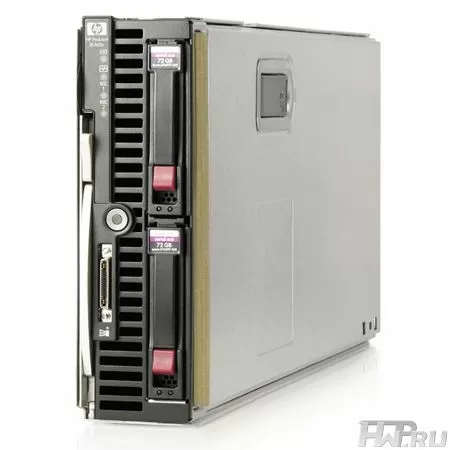
HP ProLiant 460c Modern Blade Server: Smaller and More Cost Effective
At present, for example, one HP ProLiant 460c Blade server is as powerful and resilient as the 1U HP ProLiant DL360 Slim Rack Server. At the same time, 1 Blade-chassis HP BladeSystem, 10U high, can accommodate 16 HP ProLiant 460c servers. Thus, a standard 42U rack will fit 42 HP ProLiant DL360 G6 servers or 4 x 16 = 64 HP ProLiant 460c servers. At the same time, Blade servers are easier to manage and administer, they will use less power, while generating less heat. The work of the maintenance staff is also reduced due to the decrease in the number of cables suitable for the server rack, at times.
Gradually, Blade servers were able to use most of the technologies used in conventional rack servers. Full-featured RAID controllers were introduced using hot-swappable disks. "Blades" support popular communication technologies - network adapters and Gigabit Ethernet switches, fiber-optic adapters and Fiber Channel switches, high-speed Infiniband connections. Nowadays, most blade systems do not have a single point of failure - all major system components are duplicated for fault tolerance. And if a Blade server fails, it can be replaced entirely and restore operation in a short time.

A Blade can be installed in the chassis instead of a Server Blade
The latest innovations in the Blade world include Storage-Blade (storage), Tape-Blade (tape) and PCI-Blade. The first are blades that are packed with hard drives as much as possible, and in fact are external disk cages for conventional "blades" installed in the chassis. The latter are blades that fit a modern tape drive in a form factor. The third of these "blades" are blades for installing full-height cards with PCI, PCI-x, or PCI-e interfaces. They are designed to address the internal scalability of Blade servers.
Thus, in an effort to consolidate resources, the manufacturer offers companies a single unit that combines computing resources (Blade servers) with expansion options that are not inferior to conventional servers (support for multiple multi-core processors and large amounts of memory " blades, internal mezzanine cards plus PCI blades), storage systems (storage blades), and backup devices (tape blades).
Blade Server Evolution
|
Year |
Functional changes |
The appearance of new parts in the structure |
|
2001 |
The main function of the technical system is to perform the functions of a server, when compactly placed in a server rack. 1) Blade-servers in a chassis with shared power supplies, cooling and switching modules; |
The world's first Blade system from RXL Technologies. |
|
2002 | 1) the ability to install large amounts of RAM in the "blades";
2) the ability to install conventional server processors in the "blades"; 3) hardware and software for monitoring and controlling the blades in the chassis; 4) the ability to install modular Ethernet switches in the chassis, connected to the "blades" via an internal bus. |
Increased number of slots for installing memory modules. Blade support for conventional server processors of the day. Control module in the chassis. Modular Ethernet switches in a chassis. |
|
2003 | 1) the ability to install Fiber Channel and Infiniband expansion card interfaces into the "blades" and install the corresponding switches in the chassis;
2) availability of various models of Blade-servers: from "light" (in terms of power corresponding to a personal computer) to "heavy" (in terms of performance they are not inferior to mid-level servers); 3) the ability to install hot-swappable SCSI disks in the "blades" used in conventional servers; 4) the ability to install in the "blades" dual-core processors adapted from conventional servers. |
Multifunction Mezzanine slots in blades that support Ethernet, Fiber Channel, Infiniband adapters. Different sizes and functionality of blades installed in one chassis. Full-featured RAID controller that supports hot-swappable SCSI drives. |
|
2004 | 1) the emergence of Blade-systems without a "single point of failure";
2) delivery of Blade-chassis with a special modular cooling system; 3) the emergence of "blades" supporting AMD Opteron processors. |
Fault-tolerant Blade components. Server rack for a water-cooled blade chassis. |
|
2005 | 1) more compaction of Blade-systems components, due to the rearrangement of system components, less space occupied by the server rack;
2) the emergence of "blades" supporting SPARC and Intel Itanium processors. | |
|
2006 | 1) support for Intel quad-core processors in Blade systems;
2) the emergence of "Storage Blades". |
Storage blades that work in the same chassis as conventional blades. |
|
2007 | 1) the emergence of Tape Blades;
2) the emergence of "PCI blades". |
Tape blades and PCI blades working in the same chassis as conventional blades. |
The future of the Blade-server market
Currently, the Blade-server market is developing rapidly - new blade models are released, both hardware and software are updated. However, the following fact interferes with making optimistic forecasts. Despite the fact that, on the one hand, solutions based on Blade-servers in many respects are not inferior to classical solutions (for example, in terms of power, scalability, manageability, reliability) and even are often unique, on the other hand, it is precisely the architectural features that lead to that Blade servers are often viewed with apprehension as a breaker of established traditions. Another reason is the relatively high cost of implementing systems. If the expansion of a company's IT system is usually done by installing additional computers, then a chassis with even a small number of installed blades can cost more than separate servers of similar capacity, especially if the solution involves the use of non-trivial data storage. Perhaps the “virtual” fear of being tied to one supplier also plays a role, since the system requires significant investments and is not always easy to integrate into the existing software and hardware park. Clear planning for the development of the company's IT structure and choosing the right supplier can help with these problems.
The lack of open standards for hardware chassis design also plays a negative role in the development of the blade solutions market (and this is despite the fact that solutions from different companies are often, in fact, small variations of the same design). With software, the situation is a little easier, since modern blades are based on standard equipment and, if desired, everything can be implemented using popular software.
With the advent of Blade systems, the terms consolidation and virtualization of information infrastructure have been increasingly mentioned. IT leaders have long sought a way to eradicate patchwork infrastructure by consolidating all key infrastructure elements into a single system, controlled from a single management console. Already, the possibility of combining Blade servers of a chassis or an entire rack into a "one, large" virtual server and allocating the exact amount of production capacity for solving a particular task is being implemented. Blade servers simplify the creation and use of virtual networks (VLANs), as well as bring extraordinary ease of management.
HP experts predict: in the near future tower servers will leave the market, only rack servers will remain, including the already mentioned representatives of the 6th generation, HP ProLiant DL360G6, HP ProLiant DL380 G6, HP ProLiant DL180 G6 and Blade servers. Moreover, the latter will be more common, and will gradually displace rack servers from the market. According to analysts' forecasts, by 2009 the share of blades in the total server market will cross the threshold of 30%, and the volume of sales will reach $ 9 billion (data of the analytical service IDC).
Modern Blade Samples
Let's compare three popular Blade systems.
- Side indicators are within normal limits.
- Input factors are the same for all considered technical systems.
- Prices are approximate, accurate enough to compare systems with each other.
- Performance was evaluated in points based on the maximum number of computational processors and the amount of RAM supported by the system.
|
Quality indicators of Blade-servers from different manufacturers | |||
|
Criteria |
HP BladeSystem c-class |
IBM BladeCenter H |
Dell PowerEdge 1955 |
|
Blade height, U |
10 |
9 |
7 |
|
Number of fault-tolerant components, pcs |
5 |
4 |
3 |
|
Possibility to install additional expansion cards |
Yes |
Yes |
No |
|
Blade performance, points |
5 |
4.5 |
4 |
|
Cost, USD |
19 000 |
21 000 |
13 000 |
HP BladeSystem C-class
IBM BladeCenter H
HP BladeSystem c-class and IBM BladeCenter H are closest competitors and have similar technical performance. These are the most prominent representatives of the Blade market. Let's call them high-end Blade systems.
High-end blade server subsystems: processor, system bus, RAM, interface controllers, disk controller, hard drives, backplane, cooling modules, power modules, separate control module, module for local connection to Blade system, interface switches, module for connecting PCI cards.
Dell PowerEdge 1955
Dell PowerEdge 1955 is a simpler system, not burdened with additional "bells and whistles", but, nevertheless, shows good performance and does not take up much rack space. Dell PowerEdge 1955 is a mid-range Blade.
Number of technical parts for mid-range Blade systems: processor, system bus, RAM, interface controllers, disk controller, hard disks, backplane, cooling modules, power modules, separate control module, interface switches.
Analyzing the results obtained, we can conclude that Blade systems of the highest and middle levels have small imperfection coefficients. The structure of Blade systems is close to optimal. Although it consists of a large number of technical parts, each part has its own unique role, and they all create what is called a Blade system.
Comparing the results obtained in the course of determining the perfection of technical systems with the data on the sales volumes in recent years, we can say that, despite the greater perfection of middle class Blade systems, top class Blade systems are sold better. This is due to the fact that such giants of the IT industry as HP and IBM are engaged in their production. The prestige of the brand, successful promotions, as well as good conditions for the provision of technical support from the manufacturer, persuade the buyer to purchase such systems. Top-tier blade systems are also equipped with the most technological innovations, which is very attractive to the buyer.
When should you switch to Blade servers?
At the time of writing this review, HP supplied Blade servers to several hundred customers on the Russian market. They belonged to various vertical markets (banks and finance, industry, trade, distribution of goods, science and education, transport, government agencies and departments, etc.). Accordingly, the size of customers and the number of servers in their processing centers also varied significantly.
In the most general form, the main motive for the transition to the procurement of Blade systems is the general modernization of the server facilities and the desire of customers to move from the existing server zoo to a more modern and ordered system of servers in the organization. In these cases, the customer chooses Blade systems as the most modern and promising solution for standardizing servers in an organization.
An important additional argument in favor of choosing Blade systems is whether the customer has a real or planned storage consolidation solution. This consideration is also supported by the fact that requests for server blade specifications very often involve ordering HP EVA or MSA arrays for HP Blade systems. Indeed, the simultaneous migration to blades and consolidated data storage has the advantage of no longer needing to store large amounts of data in external memory of the server Blades themselves, and in all other respects, modern blades are not inferior to their rack counterparts.


